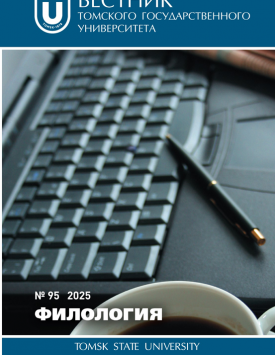Essential vectors of semantic development of the adjective toxic
The article aims to study the essential vectors of the development of the adjective toxic. The research is based on etymological and explanatory dictionaries of the English language, contexts presented in the British National Corpus (BNC), Corpus of Contemporary American English (COCA), Corpus of US Supreme Court Opinions (SCOTUS), NOW Corpus (News on the Web), Corpus iWeb (The 14 Billion Word Web Corpus), Corpus GloWbE (Global Web-based English) and authentic texts of mass media. The analysis of dictionary definitions makes it possible to identify the most distinctive features and interpretations of the word fixing the frequent and semantically similar word usage of the lexeme. On the one hand, chemicals, toxins of animals and plants can be poisonous or harmful to humans and any living organisms in case of direct exposure and ingestion. On the other hand, toxic can express the behavior of a person who makes an unpleasant emotional impression. In addition to the direct meanings such as poisonous, toxic, toxical, and harmful, the following figurative meanings can be seen: toxic, problematic, unpleasant and unacceptable. The study of 10,000 uses of the adjective toxic in the texts of linguistic corpora shows that the development of the seme "toxic" in a figurative sense is one of the essential vectors contributing to the expansion of the semantic volume of the lexeme. The contextual analysis allows to reveal a nonfixed direct meaning of toxic - dangerous - and figurative meanings: unhealthy, destructive, hostile, and sarcastic. The conducted analysis confirms the use of metaphorical epithets aand oxymorons which contribute to the vivid realization of the figurative meanings of the adjective toxic. The quantitative analysis of the lexeme in textual fragments presented in BNC, COCA, NOW and iWeb shows 70% of direct meanings and 30% of figurative meanings, respectively. However, the NOW Corpus that contains texts from 2010 to the present points out a sufficient preponderance of figurative meanings (54%) in comparison with direct ones (46%). The obtained data indicate the consistent penetration of toxic into all spheres of human life and consequently the fast-pace process of semantic derivation. Thus, the expansion of the semantic scope of the adjective toxic is caused by the development of the figurative meaning toxic due to the emergence of semantically derived meanings, lexical-semantic deviation, as well as the use of stylistic figures: metaphorical epithets and oxymorons. The revealed vectors determining semantic changes of the adjective toxic demonstrate the intensive dynamics of its development. The authors declare no conflicts of interests.
Keywords
semantic development of adjective toxic,
component analysis of word,
metaphorical epithet,
oxymoron,
figurative meaning of wordAuthors
| Ryzhkova Tatyana S. | Irkutsk National Research Technical University | ryzhkova08@mail.ru |
| Zaykova Irina V. | Irkutsk National Research Technical University | irazaykova@mail.ru |
Всего: 2
References
Daiu S. Semantic Changes - the Factors and Consequences of the Word Meaning Process // European Journal of September-December Language and Literature Studies. 2015. Vol. 1 (3). 46-52.
Медведева А.В. Особенности развития значения прилагательных // Филологические науки. 2009. № 4. С. 107-117.
Orlova E. V. Reasons for Semantic Extension in the Meaning of Artistic Symbols // Perm University Herald.Russian and Foreign Philology, 2023. Vol. 15, № 2. P. 114-120.
Кустова Г.И. Типы производных значений и механизмы языкового расширения. М. : Языки славянской культуры, 2004. 472 с.
Москалева М.В. Расширение значения слова как один из основных семантических процессов (на примере имен существительных) // Известия Российского государственного педагогического университета им. А.И. Герцена, 2007. Т. 12, № 33. С. 180-184.
Морозенко Е.А. Механизм семантической деривации оценочных прилагательных в английском языке // Studia Germanica, Romanica et Comparatistica. 2019. Т. 15, № 1-2 (43-44). С. 32-42.
Сюткина Н.П. К вопросу о расширении семантического потенциала немецкого глагола «schuren» // Евразийский гуманитарный журнал. 2020. № 2. С. 49-54.
Кононова М.Н. Прилагательное eternal: особенности функционирования (на материале исторического корпуса американского английского языка) // Евразийский вестник гуманитарных исследований. 2014. № 1 (1). С. 75-82.
Brattli T. Recent Semantic Changes for the Term «Digital» // Proceedings from the Document Academy. 2016. № 3 (2). URL: https://ideaexchange.uakron.edu/docam/vol3/iss2/16 (дата обращения: 02.05.2023).
Рыжкова Т.С., Зайкова И.В. Семантический объем прилагательного friendly в современном английском языке // Вестник Томского государственного университета. Филология. 2021. № 72. С. 134-152.
Шилихина К.М. Семантическое развитие прилагательных ядовитый и токсичный: что «отравляет» нашу жизнь? // Вестник Воронежского государственного университета. Серия: Лингвистика и межкультурная коммуникация. 2019. № 2. С. 86-93.
Поляк Т.В. Англосемантизация прилагательного токсичный в речевых практиках носителей современного русского языка // Дни науки - 2020 в Институте гуманитарных наук : сб. ст. науч.-практ. конф. студентов, аспирантов и молодых ученых, Калининград, 15-23 мая 2020 г. Калининград : Балтийский федеральный университет имени Иммануила Канта, 2022. С. 57-62.
Online Etymology Dictionary. URL: https://www.etymonline.com/(дата обращения: 01.04.2023).
Longman Dictionary of Contemporary English. URL: https://www.ldoceonline.com/(дата обращения 17.04.2023).
Early English Books Online. URL: https://www.english-corpora.org/eebo/(дата обращения 04.07.2023).
Collins English Dictionary. URL: https://www.coUinsdictionary.com (дата обращения: 17.04.2023).
Macmillan English Dictionary for Advanced Learners. URL: https://www.macmillandictionary.com/(дата обращения: 29.04.2023).
Merriam-Webster Dictionary. URL: https://www.merriam-webster.com/(дата обращения: 16.04.2023).
Cambridge Dictionary. URL: https://dictionary.cambridge.org/(дата обращения: 16.04.2023).
Oxford Advanced Learner's Dictionary. URL: https://www.oxfordlearnersdictionar-ies.com/(дата обращения 29.04.2023).
Корпус современного американского английского языка. URL: https://www.english-corpora.org/coca/(дата обращения: 29.04.2023).
Британский национальный корпус. URL: https://www.english-corpora.org/bnc/(дата обращения: 10.04.2023).
Корпус NOW (News on the Web). URL: https://www.english-corpora.org/now/(дата обращения: 16.05.2023).
Корпус GloWbE (Global Web-based English). URL: https://www.english-corpora.org/glowbe/(Дата обращения: 29.05.2023).
Mayo Clinic College of Medicine and Science. URL: https://college.mayo.edu/(дата обращения: 20.09.2023).
Корпус iWeb (The 14 Billion Word Web Corpus). URL: https://www.english-corpora.org/iweb/(дата обращения: 10.05.2023).
Корпус решений Верховного Суда США. URL: https://www.englishcorpora.org/scotus/(дата обращения: 17.05.2023).
Urban Dictionary. URL: https://www.urbandictionary.com/(дата обращения: 20.05.2023).

